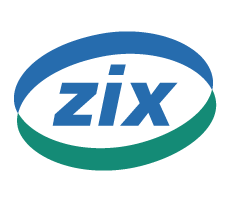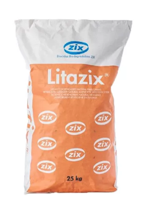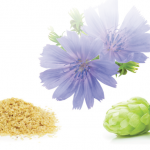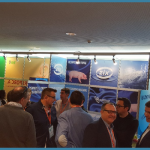The Porcine Reproductive and Respiratory Syndrome (PRRS) became one of the greatest challenges in pig production since its appearance at the end of the last century. This virus represents a very important risk in areas with a high density of pig farms due to the implications it entails and the high economic losses it generates, which some authors place between € 100 and € 200 per sow.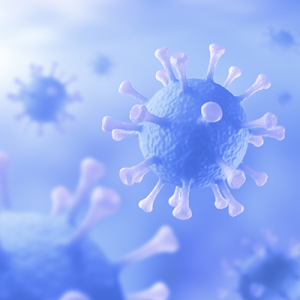
Caused by an RNA Virus, of the Arteriviridae family, with a high mutation rate, this syndrome can manifest itself in two main ways.
- In its reproductive form, where we will mainly see affectation in the sows, with abortions in the last third of gestation, premature births, births of unequal litters, mummified and/or weak piglets with little viability. In males, although the affectation is not going to be so apparent, it is possible to see periods of depression, lethargy, and loss of sperm quality.
- In its respiratory form, where we will mainly find greater problems in animals in post-weaning, transition, and fattening phases, we will see typical symptoms of respiratory processes, such as dyspnea, pneumonia, anorexia, lethargy, fever, delayed growth, and high mortality.
All these processes favour a significant worsening of zootechnical parameters, contributing to large economic losses.
Which characteristics does the virus have and how does it spread?
It is not a particularly resistant virus when it is free in the environment due to its characteristics, although long survival has been seen in certain conditions of low temperatures.
The problem is that it is a highly contagious virus since it can enter the farm through new animals or semen, as well as through vehicles, insects, personnel, equipment, or even transported by air. Subsequently, there can be both horizontal and vertical transmission once inside the farm. Within a farm, the PRRS virus can survive endemically due to the constant flow of susceptible animals. So having a biosecurity plan is essential.
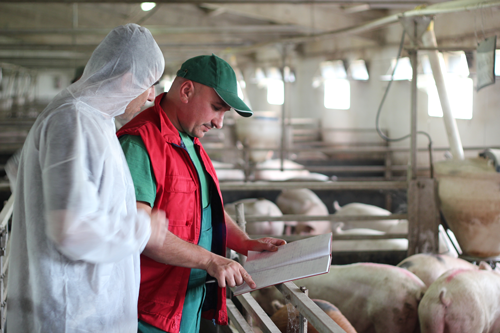
In addition, as we have commented previously, it is a virus with a high mutational rate, which is an obstacle to maintaining stable farms and therefore will make the strategy to be followed more complex, having to pay special attention to the state of the farm animals, the health status of the replacement animals and even that of our neighbours.
That is why many companies consider whether the goal is to be free or to live with controlled PRRS viruses and take the appropriate biosafety measures to keep them away.
Once the virus is known, we can check the importance of implementing a good plan to avoid these high economic losses on our farm, and we can establish a biosafety plan. Diagnosis, control, and vaccination strategies are established that are beneficial to combat it, but nothing would be possible without good management and optimal biosafety measures, which help us avoid its spread.
It is essential to reinforce external biosafety, controlling the entry of new animals and semen, as well as internal biosafety, which is more focused on the measures applied in the farm itself. Within these measures, it will be essential to establish a good cleaning and disinfection plan, which allows optimal hygiene of the farm, vehicles, equipment, and personnel, to avoid that we have to consider as if everything that enters from outside can act as a fomite for the virus. For this, from Biocidas ZIX, we have a wide range of products that will help us achieve these objectives..
Detergents:
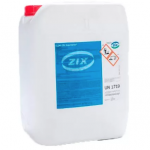 Livestock farms are places where conditions of high content of organic matter, heat, humidity, and high density meet, these conditions make our facilities the optimal place for the proliferation of pathogenic organisms
Livestock farms are places where conditions of high content of organic matter, heat, humidity, and high density meet, these conditions make our facilities the optimal place for the proliferation of pathogenic organisms
- As a first step, it is necessary to carry out a correct cleaning with an alkaline detergent capable of dragging the organic matter that, a priori, covers, and harbours said microorganisms.
- Only in this way it will be possible to pass to next stage: disinfection.
- We recommend the use of Biocide ZIX (Clean Zix Foaming) detergent to carry out a correct cleaning, descaling the organic matter, and thus expose all parts of the farm so that the disinfectants can reach the highest number of microorganisms present.
Disinfectants:
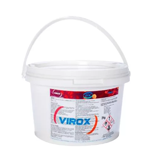 Once the cleaning is done, it is time to combat the microorganisms by fighting them with broad-spectrum products, with a nonspecific mechanism of action that prevents the appearance of resistance, that is safe to animals, staff, and the environment.
Once the cleaning is done, it is time to combat the microorganisms by fighting them with broad-spectrum products, with a nonspecific mechanism of action that prevents the appearance of resistance, that is safe to animals, staff, and the environment.
- For this, Biocidas ZIX has disinfectant products: Virox (monopersulphate in powder form) and Zix Virox (synergistic combination of peroxides and peracetic acid in liquid form).
- These products have a mechanism of action by oxidation that is nonspecific and therefore broad-spectrum and totally biodegradable.
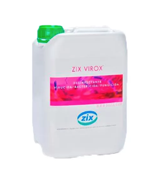 They are ideal for disinfecting surfaces (ceilings, walls, slats) slurry pits (the PRRS virus can live up to 3 days at 21ºC in the slurry), feeders, augers and liquid feeding circuits, water circuits (tanks, tanks, pipes, drinkers) footbaths, wheel baths and disinfection arches, farm tools (piglet processing carts, brushes, boards, boots …) and all other maintenance materials from outside (toolboxes, compressors, boots, etc. .)..
They are ideal for disinfecting surfaces (ceilings, walls, slats) slurry pits (the PRRS virus can live up to 3 days at 21ºC in the slurry), feeders, augers and liquid feeding circuits, water circuits (tanks, tanks, pipes, drinkers) footbaths, wheel baths and disinfection arches, farm tools (piglet processing carts, brushes, boards, boots …) and all other maintenance materials from outside (toolboxes, compressors, boots, etc. .)..
ZIX super tip
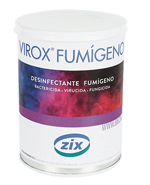
During farm empty periods, maintenance work or other visits to the facilities are carried out that can reintroduce the virus into a previously disinfected facility. For this reason, we recommend carrying out a second disinfection before the entry of animals using Virox Fumigeno.
- Potassium monopersulphate in a candle, which performs the disinfection by dry smoke, without adding humidity, without the need to use a thermal fogger or extra labour costs.
- Virox Fumigeno also allows the disinfection of hard-to-reach places inside warehouses, silos, etc.
Litazix is the Biocidas ZIX tool to reduce or eliminate humidity from the surfaces of our maternity wards and/or corridors and thereby avoid the presence of the PRRS virus, which is not very resistant to dry conditions..
Dirty farm areas.
One of the most important places for the Biosafety Plan is the loading and unloading docks because they are areas with a lot of traffic, trucks, people, and animals come into contact with them. Its design and materials must prevent the entry of possible pathogens and allow easy cleaning and disinfection that must be carried out after each use.
The transports
The vehicles that enter our farms, whether they are trucks, vans, or cars, must always be treated as contaminated elements.
- To enter the farm, they must pass through wheel baths and disinfection arches and, if necessary, show the documentation that supports their previous cleaning and disinfection.
- Outside vehicles will be the ones that present the greatest risk.
- In the case of trucks of animals, feed, or other supplies, it is important to disinfect the cabin (stairs, pedals, mats, etc.), in the trailer clean and disinfect all surfaces with special relevant corners, hinges, and all those places that are difficult to access
Supplies
All materials that are going to enter our facilities must be disinfected and remain stored for at least 2 hours before entering the clean areas of the farms.
We know more and better about the PRRS virus, but many farms remain vulnerable to its devastating effects. In places with large concentrations of animals such as southern Europe, preventive measures are our greatest ally.
Controlling the PRRS virus is everyone’s responsibility, we can help by working from our farms to our collaborators and neighbours.
